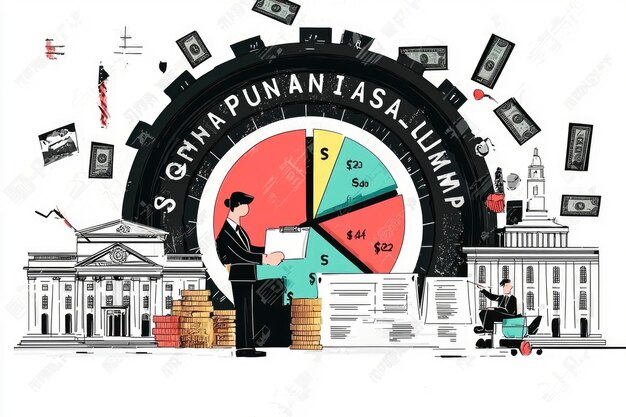Understanding how the projected 2.8% inflation rate in 2025 will impact your investment portfolio is crucial for making informed financial decisions, as it affects asset values, purchasing power, and overall investment strategies.
Navigating the complexities of the financial landscape requires a keen understanding of economic indicators. The projected 2.8% inflation rate in 2025 is one such indicator, and it’s vital to understand how will the projected 2.8% inflation rate in 2025 impact your investment portfolio.
Understanding the 2025 Inflation Projection
The announcement of a projected 2.8% inflation rate for 2025 sparks a series of questions for investors. It’s crucial to understand what this projection means and how it might deviate from long-term averages. This section examines the factors influencing the projection and its potential variability.
What Drives Inflation Projections?
Inflation projections are based on a complex interplay of economic factors. These include government spending, monetary policy decisions by the Federal Reserve, global supply chain dynamics, and consumer demand. Each of these factors can significantly influence the overall inflation rate.
Economists use sophisticated models to forecast inflation, but these models are not always perfect. Unforeseen events, such as geopolitical conflicts or unexpected supply chain disruptions, can lead to deviations from the projected path.

Potential Variability and Unexpected Events
While a 2.8% inflation rate is the current projection, it’s important to remember that this is just an estimate. Actual inflation rates can fluctuate due to unexpected events, such as sudden increases in energy prices, or shifts in consumer sentiment. Understanding the potential for variability is essential for investors.
- Geopolitical Instability: Conflicts or trade wars can disrupt supply chains and increase prices.
- Technological Disruptions: Rapid advancements can impact productivity and price levels.
- Policy Changes: Unexpected shifts in fiscal or monetary policy can alter the economic landscape.
In conclusion, understanding the 2025 inflation projection requires a thorough understanding of the economic factors at play and the potential for unexpected events to influence the actual inflation rate. This awareness is critical for making informed investment decisions.
How Inflation Impacts Different Asset Classes
Inflation doesn’t impact all asset classes equally. Certain investments tend to perform better during inflationary periods, while others may suffer. This section breaks down how different asset classes are likely to be affected by the projected 2.8% inflation rate in 2025.
Winners and Losers in an inflationary Environment
Historically, certain asset classes have offered a hedge against inflation. Real estate, commodities, and inflation-protected securities (TIPS) are often seen as safe havens during inflationary periods. On the other hand, fixed-income investments like bonds may lose value as inflation erodes their purchasing power.
Equities, or stocks, can be a mixed bag. Companies with pricing power—those that can pass on increased costs to consumers—may perform well. However, companies with fixed-price contracts or those in highly competitive industries may struggle.
Real Estate and Commodities: Traditional Inflation Hedges
Real estate is often considered an inflation hedge because property values and rental income tend to rise with inflation. Commodities, such as gold, oil, and agricultural products, can also benefit from rising prices as their supply may be limited.
- Real Estate: Rental income and property values tend to increase with inflation.
- Commodities: Prices of raw materials often rise during inflationary periods.
- Inflation-Protected Securities (TIPS): These bonds are designed to protect investors from inflation.

Understanding how different asset classes react to inflation is essential for building a resilient investment portfolio. By diversifying your investments across various asset classes, you can mitigate the risks associated with inflation and position yourself for potential gains.
Strategies to Protect Your Investment Portfolio
Protecting your investment portfolio from the adverse effects of inflation requires a proactive approach. This section outlines several strategies that investors can use to safeguard their wealth and maintain their purchasing power during inflationary periods.
Diversification and Asset Allocation
Diversification is a cornerstone of sound investment strategy. By spreading your investments across different asset classes, you can reduce your overall risk and increase your chances of achieving your financial goals. During inflationary periods, diversification can help you mitigate losses and capitalize on opportunities.
Asset allocation involves determining the appropriate mix of assets in your portfolio based on your risk tolerance, time horizon, and financial goals. A well-designed asset allocation strategy can help you navigate the challenges of inflation and build long-term wealth.
Investing in Inflation-Resistant Assets
As mentioned earlier, certain assets tend to perform better during inflationary periods. Consider investing in real estate, commodities, and inflation-protected securities (TIPS) to protect your portfolio from the erosion of purchasing power. These assets can provide a hedge against inflation and help you maintain your financial stability.
Another strategy is to invest in companies with pricing power. These companies can pass on increased costs to consumers, maintaining their profitability and shareholder value. Look for companies with strong brands, loyal customers, and a competitive advantage.
In conclusion, protecting your investment portfolio from inflation requires a combination of diversification, asset allocation, and investing in inflation-resistant assets. By implementing these strategies, you can mitigate the risks associated with inflation and position yourself for long-term financial success.
Adjusting Your Investment Strategy for 2025
Given the projected 2.8% inflation rate for 2025, it’s prudent to consider adjustments to your investment strategy. This section provides actionable steps you can take to optimize your portfolio for the expected economic environment.
Re-evaluating Risk Tolerance and Time Horizon
The projected inflation rate may warrant a reassessment of your risk tolerance and time horizon. If you have a long time horizon, you may be able to take on more risk and invest in assets with higher growth potential. However, if you are approaching retirement, you may want to reduce your risk and focus on preserving your capital.
Inflation can erode the real value of your investments over time, so it’s essential to factor this into your financial planning. Consider increasing your savings rate, delaying retirement, or adjusting your spending habits to account for the impact of inflation.
Consulting a Financial Advisor
Navigating the complexities of inflation and investment management can be challenging. Consulting a qualified financial advisor can provide valuable insights and guidance. A financial advisor can help you assess your financial situation, develop a customized investment strategy, and monitor your progress over time.
- Assess Your Financial Situation: Understand your current assets, liabilities, and cash flow.
- Develop a Customized Investment Strategy: Align your investments with your goals and risk tolerance.
- Monitor Your Progress: Track your performance and make adjustments as needed.
By taking these steps, you can adjust your investment strategy for 2025 and position yourself for financial success in the face of inflation. Remember, a proactive and well-informed approach is key to achieving your financial goals.
The Role of Monetary Policy and the Federal Reserve
Monetary policy, implemented by the Federal Reserve (the Fed), plays a crucial role in managing inflation. This section explores how the Fed’s actions can influence inflation rates and how these actions might affect your investment portfolio.
How the Fed Controls Inflation
The Fed has several tools at its disposal to control inflation. These include adjusting the federal funds rate, which is the target rate that banks charge each other for overnight lending, and buying or selling government bonds, which affects the money supply.
Raising interest rates can help cool down an overheated economy and reduce inflationary pressures. However, higher interest rates can also slow down economic growth and potentially lead to a recession. The Fed must carefully balance the risks of inflation and recession when making monetary policy decisions.
Potential Impacts on Investment Returns
The Fed’s monetary policy decisions can have a significant impact on investment returns. Higher interest rates can lead to lower bond prices and potentially lower stock prices. On the other hand, lower interest rates can boost asset prices and stimulate economic growth.
Investors should pay close attention to the Fed’s announcements and statements to anticipate potential changes in monetary policy. Understanding the Fed’s likely course of action can help you make informed investment decisions and adjust your portfolio accordingly.
In conclusion, the Federal Reserve plays a critical role in managing inflation, and its monetary policy decisions can have a profound impact on investment returns. By staying informed about the Fed’s actions, you can better navigate the complexities of the financial landscape and protect your investment portfolio.
Long-Term Investment Planning in an Inflationary Environment
Inflation is a persistent factor in the economic landscape, and it’s crucial to incorporate it into your long-term investment planning. This section offers guidance on how to build a robust investment strategy that can withstand the challenges of inflation and help you achieve your financial goals.
Setting Realistic Financial Goals
Your financial goals should be realistic and aligned with your risk tolerance, time horizon, and financial resources. When setting your goals, consider the impact of inflation on your purchasing power and adjust your savings and investment targets accordingly.
Remember that inflation can erode the real value of your savings over time, so it’s essential to factor this into your long-term planning. Consider increasing your savings rate, delaying retirement, or adjusting your spending habits to account for the impact of inflation.
Periodic Portfolio Reviews and Adjustments
Your investment portfolio should be reviewed and adjusted periodically to ensure that it remains aligned with your goals and risk tolerance. Market conditions, economic trends, and your personal circumstances can change over time, so it’s essential to adapt your strategy accordingly.
- Rebalance Your Portfolio: Maintain your desired asset allocation by rebalancing regularly.
- Review Your Investment Strategy: Ensure your strategy aligns with your goals and risk tolerance.
- Seek Professional Advice: Consult a financial advisor for guidance and support.
By incorporating inflation into your long-term investment planning and periodically reviewing and adjusting your portfolio, you can increase your chances of achieving your financial goals and building long-term wealth. Remember, a proactive and well-informed approach is key to success.
| Key Point | Brief Description |
|---|---|
| 📈 Inflation Projection | The 2025 projected inflation rate is 2.8%, impacting investment strategies. |
| 🛡️ Asset Protection | Strategies include diversification, inflation-resistant assets, and portfolio adjustments. |
| 🏦 Monetary Policy | The Federal Reserve’s actions to control inflation affect investment returns. |
| 🎯 Long-Term Planning | Set realistic goals and periodically review your portfolio to adapt to inflation. |
Frequently Asked Questions
▼
The projected inflation rate for 2025 is estimated to be 2.8%. This rate is an important economic indicator that investors should consider when planning their investment strategies.
▼
Inflation erodes the purchasing power of your investments. It can affect different asset classes differently, potentially reducing the real value of your returns over time.
▼
Diversification, investing in inflation-resistant assets like real estate and commodities, and adjusting your asset allocation are some effective strategies. Consulting a financial advisor is also beneficial.
▼
The Federal Reserve uses monetary policy tools such as adjusting interest rates and managing the money supply to control inflation and maintain economic stability. Their actions significantly impact investment returns.
▼
It is advisable to review your investment portfolio at least annually, or even more frequently during periods of high inflation, to ensure it remains aligned with your financial goals and risk tolerance.
Conclusion
Understanding the projected 2.8% inflation rate in 2025 and its potential impact on your investment portfolio is crucial for making informed financial decisions. By implementing proactive strategies such as diversification, investing in inflation-resistant assets, and regularly reviewing your portfolio, you can mitigate the risks associated with inflation and position yourself for long-term financial success.

 New Tax Law Changes in 2025: How the Capital Gains Tax Increase Impacts You
New Tax Law Changes in 2025: How the Capital Gains Tax Increase Impacts You  Navigating the 2025 Tax Law: A 10% Capital Gains Tax Increase
Navigating the 2025 Tax Law: A 10% Capital Gains Tax Increase  LowRiskInvesting: Strategies for Smart Investors
LowRiskInvesting: Strategies for Smart Investors